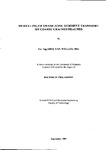MODELLING OF SWASH ZONE SEDIMENT TRANSPORT ON COARSE GRAINED BEACHES
| dc.contributor.author | VAN WELLEN, EUR ING ERIK | |
| dc.contributor.other | School of Engineering, Computing and Mathematics | en_US |
| dc.date.accessioned | 2013-09-16T12:22:32Z | |
| dc.date.available | 2013-09-16T12:22:32Z | |
| dc.date.issued | 1999 | |
| dc.identifier | NOT AVAILABLE | en_US |
| dc.identifier.uri | http://hdl.handle.net/10026.1/1761 | |
| dc.description.abstract |
A review is presented which assesses the importance of the swash zone as a potential contributor to the longshore and cross-shore transport on steep coarse-grained beaches. Based on this review it is apparent that the swash zone on such beaches forms an important contributor to both the longshore and the cross-shore transport. The review also identifies that the swash zone is neglected in all but a few sediment transport models. In addition, a lack of available shingle beach field data against which to validate existing and new transport models is also reported. Two surf zone integrated equations are presented with the aim of producing simple and physics based formulae relating the total longshore transport (TLT) to the main parameters such as wave height at breaking. In addition, a surf and swash zone inclusive transport formula is developed based on an existing numerical model for the calculation of shingle transport. These formulae, together with existing TLT formulae are evaluated against existing, synthesised and new field data collected during this study. A mathematical model (STRAND) is developed which quantifies sediment transport in the swash zone. The model combines recent advances in the understanding of swash zone dynamics with physics-based predictive transport equations and is computationally efficient. Sensitivity analyses on the model confirm the high potential for transport in the swash zone, both cross-shore and longshore. The STRAND model gives good results when tested against existing data and new field data from shingle beaches at Shoreham-by-Sea and Lancing. Although originally developed for shingle beaches, the model is also validated using data from sand beaches, thus encompassing a wider variety of sediment sizes than many models have used for tests in the past. The swash zone on steep beaches is found to be responsible for as much as two thirds of the volumetric longshore transport. The model also indicated high and rapidly fluctuating cross-shore transport rates, thus contradicting existing transport distribution models. Therefore, sediment transport in the swash zone on steep beaches can no longer be ignored as an important contributor to the overall longshore and cross-shore transport budgets. | en_US |
| dc.language.iso | en | en_US |
| dc.publisher | University of Plymouth | en_US |
| dc.title | MODELLING OF SWASH ZONE SEDIMENT TRANSPORT ON COARSE GRAINED BEACHES | en_US |
| dc.type | Thesis | |
| plymouth.version | Full version | en_US |
| dc.identifier.doi | http://dx.doi.org/10.24382/3524 | |
| dc.identifier.doi | http://dx.doi.org/10.24382/3524 |
Files in this item
This item appears in the following Collection(s)
-
01 Research Theses Main Collection
Research Theses Main


